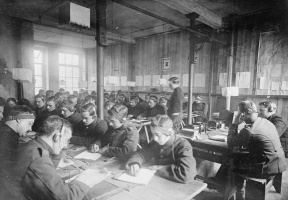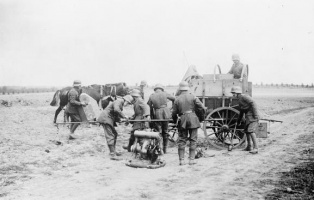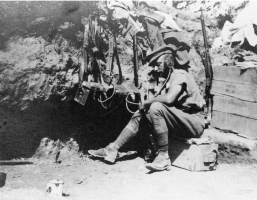Technical Development↑
Wireless was one of myriad novel technologies employed during World War I. It created new spaces for communications at sea and in the air as well as the ability to coordinate mobile units during battle. By 1918, advances in wireless technology had laid the groundwork for communications strategies during World War II.
Wireless telegraphy emerged in the 1890s and transmitted Morse code through electromagnetic waves. Only in the 1920s did the transmission of speech through radiotelephony begin to replace wireless telegraphy. Initially, many felt that the dense telegraph system negated the need for wireless to communicate on land. Navies were generally the first to see potential in wireless, as the technology allowed them to coordinate their ships’ maneuvers. All ninety German warships were equipped with wireless in 1909; in 1912, the former first sea lord, Admiral Sir John Fisher (1841–1920), called wireless “the pith and marrow of war!”[1] Germans focused more heavily than other countries on employing wireless in multiple arenas, though other combatants used wireless extensively by 1917–1918. More broadly, wireless telegraphy was a key technology that globalized conflict both militarily and through news.
Wireless in Colonies↑
Aside from its naval purposes, wireless enabled governments to reach their colonies without using Britain’s “All Red Line” of submarine telegraph cables around the world. In the few years before 1914, Germans erected wireless towers in their colonies in Africa as well as in East Asia and the Pacific, including Qingdao, Nauru, and Samoa. When war broke out, these wireless-equipped areas became priorities for Allied forces. At the battle of Bitapaka on 11 September 1914, Australian forces attacked a German wireless station on the island of New Britain, conquering German New Guinea. By October 1914, the British had destroyed German wireless stations on the strategically important island of Yap, and by early 1915 in southwest Africa. In east Africa, a British wireless installation at Mombasa intercepted German wireless from Lake Victoria until June 1915 or later.
Wireless on the Battlefield↑
Wireless also became a critical element of battlefield tactics and strategy in Europe and north Africa. In 1914, armies remained as skeptical about wireless as navies were enthusiastic. All armies searched for secure methods of communications; wireless could be easily intercepted. Wireless sets were heavy and not particularly portable, and transmissions remained relatively unreliable. The transmission range also varied wildly depending upon atmospheric conditions.
The German military embraced the possibilities of wireless widely, supplying every army headquarters and cavalry division with wireless. The German defensive strategy on the western front made it easier to erect more permanent wireless stations in the trenches. Moreover, the Allied naval blockade from 1916 restricted German supplies of raw materials like copper to create telephone cables. Further, Germans were already highly invested in improving wireless to disseminate information because the British had cut submarine cables to Germany in 1914.
By contrast, the British Army adopted wireless slowly, missing an opportunity to diversify its communications strategy. The British relied more upon telephones during the initial years of trench warfare, as well as visual signaling through flags, lamps, and heliograph. The Army only began to investigate portable wireless sets for trench warfare in mid-1915. Telephone lines buried underground remained the backbone of the Army’s communications system during the Battle of the Somme in 1916, but the wireless British Forces’ trench set proved its worth by enabling communications when cables were destroyed. In the last two years of the war, the British Army invested more heavily in wireless, and by mid-1917, they viewed wireless as a valid means of communication.
Aided by French and British technical innovation in radio valves and receivers, the British Army manufactured several hundred CW (continuous wave) wireless sets in mid-1917. Unlike the previous spark-based sets, CW sets had a range of eleven kilometers or more. The introduction of tanks at the Battle of Cambrai in November 1917 heightened the need for wireless because it enabled commands to coordinate the movements of the mobile tanks. The Allies most successfully implemented this tactic at their devastating attack on the Germans at Le Hamel in July 1918, which employed wireless to coordinate tanks, infantry, artillery, and aerial observation.
On the eastern front, the German Army intercepted Russian wireless communications, providing critical information about Russian tactics at the Battle of Tannenberg in August 1914. The British Army also used wireless extensively in the Middle East, particularly in Mesopotamia and east Africa because of the large distances and lack of other means of communication. Wireless thus played a critical role in enabling and coordinating swifter and more mobile warfare.
Wireless Under the Sea and In the Air↑
At sea, too, the German Navy employed wireless more than anyone else in order to intercept enemy wireless intelligence, coordinate submarines, and communicate with trade ships. The U.S. Navy recruited many wireless operators to assist its submarine campaign after entering the war in April 1917. Though the German Imperial Navy used a codebook to prevent interception of its own messages, the British already possessed a copy when the war broke out. The codebook formed the basis for Room 40, the British Admiralty’s major cryptoanalysis section during the war.
By the end of the war, wireless also facilitated ground-to-air communications. In 1915, Captain Hugh Dowding (1882–1970) became the first Briton to receive radio signals in the air. Dowding later worked as air chief marshal during the Battle of Britain in 1940, when wireless communications vitally aided Britain’s success in resisting German invasion. Although the British War Office initially rejected investment in airborne wireless, by 1917, airborne valve wireless played a vital role in spotting artillery and enabling ground-to-air communications.
Wireless News↑
Because Britain had severed the submarine cables connected to Germany in August 1914, a German state-owned news agency, Transocean, sent news over wireless to European allies, the Americas, and East Asia. In 1914, Nauen, located just outside Berlin, was the only European station capable of reaching North America. Nauen transmitted news at least twice per day to Sayville, one of two towers constructed by Telefunken on the east coast before the war. Under the supervision of the U.S. Navy, who supervised the station to ensure neutrality and enforce the law forbidding the Germans to communicate with ships, the clerks at Sayville disseminated the news via telegraph to the main American news agencies. In October 1916, Transocean’s news reached approximately 2,000 American newspapers. Transocean news spread to South America via a complicated network of cables in neutral countries in Central America, such as Guatemala. These efforts did little to significantly alter neutral countries’ perceptions of German war aims and actions.
When the United States officially declared war on Germany on 6 April 1917, one of the first hostile acts between the two countries was the U.S. Marines’ seizure of the Sayville station. By this time, however, Nauen’s range of over 11,000 kilometers meant that Sayville was no longer necessary to transmit radio signals to Asia or South America.
Conclusion↑
Historians still debate whether wireless formed a critical element of warfare, or if it could have enhanced British battlefield tactics in particular. Regardless, wireless remained contentious even after November 1918. Article 197 of the Versailles Treaty forbade Germany from sending political news from Berlin (stations in Nauen and Königs Wusterhausen) as well as Hanover (Eilvese station) for three months after the treaty went into effect. The German Foreign Office interpreted the clause literally and continued to broadcast from Norddeich, which Article 197 had not mentioned. The importance of wireless to reach distant populations and coordinate more mobile battles with tanks and aircraft remained enduring legacies that would become vital elements of the next World War.
Heidi J. S. Tworek, Harvard University
Section Editor: Frederik Schulze
Notes
- ↑ Bacon, Admiral Sir R.H. (ed.): The Life of Lord Fisher of Kilverstone, vol. 2, London 1929, p. 144.
Selected Bibliography
- Evans, Heidi J. S.: 'The path to freedom'? Transocean and German wireless telegraphy, 1914-1922, in: Historical Social Research 35/1, 2010, pp. 209-233.
- Hall, B. N.: The British Army and wireless communication, 1896-1918, in: War in History 19/3, 2012, pp. 290-321.
- Winkler, Jonathan Reed: Information warfare in World War I, in: The Journal of Military History 73/3, 2009, pp. 845-867.











